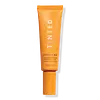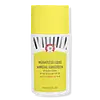What's inside
What's inside
 Key Ingredients
Key Ingredients

 Benefits
Benefits

 Concerns
Concerns

 Ingredients Side-by-side
Ingredients Side-by-side

Zinc Oxide 18.23%
Cosmetic ColorantWater
Skin ConditioningCaprylic/Capric Triglyceride
MaskingC13-15 Alkane
SolventPropanediol
SolventC15-19 Alkane
SolventBis-Diglyceryl Polyacyladipate-2
EmollientTocopherol
AntioxidantOctyldodecanol
EmollientPolyhydroxystearic Acid
EmulsifyingInositol
HumectantHippophae Rhamnoides Oil
EmollientSilica
AbrasivePolyacrylate Crosspolymer-6
Emulsion StabilisingIsostearic Acid
CleansingLecithin
EmollientPolyglyceryl-3 Polyricinoleate
EmulsifyingXanthan Gum
EmulsifyingCoco-Glucoside
CleansingPolyglycerin-3
HumectantPolyglyceryl-3 Lactate/Laurate
CleansingBisabolol
MaskingCaprylhydroxamic Acid
Sodium Dilauramidoglutamide Lysine
HumectantSodium Citrate
BufferingCitric Acid
BufferingArachidyl Glucoside
EmulsifyingSodium Phytate
Glycerin
HumectantPhysalis Alkekengi Calyx Extract
Skin ConditioningBiosaccharide Gum-1
HumectantSodium Levulinate
Skin ConditioningGlyceryl Caprylate
EmollientCetearyl Alcohol
EmollientT-Butyl Alcohol
PerfumingSodium Anisate
AntimicrobialGlucose
HumectantBeta-Carotene
Skin ConditioningBehenyl Alcohol
EmollientArachidyl Alcohol
EmollientCI 77492
Cosmetic ColorantCI 77491
Cosmetic ColorantZinc Oxide 18.23%, Water, Caprylic/Capric Triglyceride, C13-15 Alkane, Propanediol, C15-19 Alkane, Bis-Diglyceryl Polyacyladipate-2, Tocopherol, Octyldodecanol, Polyhydroxystearic Acid, Inositol, Hippophae Rhamnoides Oil, Silica, Polyacrylate Crosspolymer-6, Isostearic Acid, Lecithin, Polyglyceryl-3 Polyricinoleate, Xanthan Gum, Coco-Glucoside, Polyglycerin-3, Polyglyceryl-3 Lactate/Laurate, Bisabolol, Caprylhydroxamic Acid, Sodium Dilauramidoglutamide Lysine, Sodium Citrate, Citric Acid, Arachidyl Glucoside, Sodium Phytate, Glycerin, Physalis Alkekengi Calyx Extract, Biosaccharide Gum-1, Sodium Levulinate, Glyceryl Caprylate, Cetearyl Alcohol, T-Butyl Alcohol, Sodium Anisate, Glucose, Beta-Carotene, Behenyl Alcohol, Arachidyl Alcohol, CI 77492, CI 77491
Zinc Oxide 22%
Cosmetic ColorantEthylhexyl Olivate
Skin ConditioningIsododecane
EmollientCoconut Alkanes
EmollientWater
Skin ConditioningAluminum Starch Octenylsuccinate
AbsorbentCaprylic/Capric Triglyceride
MaskingButylene Glycol
HumectantMica
Cosmetic ColorantPolyglyceryl-6 Polyricinoleate
EmulsifyingJojoba Esters
EmollientCellulose
AbsorbentStearalkonium Hectorite
Gel FormingSodium Chloride
MaskingSqualane
EmollientPolyglyceryl-3 Diisostearate
EmulsifyingPolyglyceryl-3 Polyricinoleate
EmulsifyingIron Oxides
Phenoxyethanol
PreservativeTocopheryl Acetate
AntioxidantCoco-Caprylate/Caprate
EmollientTrihydroxystearin
Skin ConditioningCaprylyl Glycol
EmollientPolyhydroxystearic Acid
EmulsifyingGlycerin
HumectantTrisodium Ethylenediamine Disuccinate
Propanediol
SolventSorbic Acid
PreservativeTitanium Dioxide
Cosmetic ColorantSilica
AbrasiveGlycyrrhiza Glabra Root Extract
BleachingCamellia Sinensis Leaf Extract
AntimicrobialAlumina
AbrasiveTocopherol
AntioxidantChrysanthemum Parthenium Extract
Skin ConditioningZinc Oxide 22%, Ethylhexyl Olivate, Isododecane, Coconut Alkanes, Water, Aluminum Starch Octenylsuccinate, Caprylic/Capric Triglyceride, Butylene Glycol, Mica, Polyglyceryl-6 Polyricinoleate, Jojoba Esters, Cellulose, Stearalkonium Hectorite, Sodium Chloride, Squalane, Polyglyceryl-3 Diisostearate, Polyglyceryl-3 Polyricinoleate, Iron Oxides, Phenoxyethanol, Tocopheryl Acetate, Coco-Caprylate/Caprate, Trihydroxystearin, Caprylyl Glycol, Polyhydroxystearic Acid, Glycerin, Trisodium Ethylenediamine Disuccinate, Propanediol, Sorbic Acid, Titanium Dioxide, Silica, Glycyrrhiza Glabra Root Extract, Camellia Sinensis Leaf Extract, Alumina, Tocopherol, Chrysanthemum Parthenium Extract
 Reviews
Reviews

Ingredients Explained
These ingredients are found in both products.
Ingredients higher up in an ingredient list are typically present in a larger amount.
This ingredient is an emollient, solvent, and texture enhancer. It is considered a skin-softener by helping the skin prevent moisture loss.
It helps thicken a product's formula and makes it easier to spread by dissolving clumping compounds.
Caprylic Triglyceride is made by combining glycerin with coconut oil, forming a clear liquid.
While there is an assumption Caprylic Triglyceride can clog pores due to it being derived from coconut oil, there is no research supporting this.
Learn more about Caprylic/Capric TriglycerideGlycerin is already naturally found in your skin. It helps moisturize and protect your skin.
A study from 2016 found glycerin to be more effective as a humectant than AHAs and hyaluronic acid.
As a humectant, it helps the skin stay hydrated by pulling moisture to your skin. The low molecular weight of glycerin allows it to pull moisture into the deeper layers of your skin.
Hydrated skin improves your skin barrier; Your skin barrier helps protect against irritants and bacteria.
Glycerin has also been found to have antimicrobial and antiviral properties. Due to these properties, glycerin is often used in wound and burn treatments.
In cosmetics, glycerin is usually derived from plants such as soybean or palm. However, it can also be sourced from animals, such as tallow or animal fat.
This ingredient is organic, colorless, odorless, and non-toxic.
Glycerin is the name for this ingredient in American English. British English uses Glycerol/Glycerine.
Learn more about GlycerinThis ingredient is an emulsifier. It is created from Polyglycerin-3 and Ricinoleic Acid.
As an emulsifier, it prevents waters and oils from separating. According to a manufacturer this ingredient is fully biodegradable.
This ingredient may not be safe for Malassezia folliculitis due to its Ricinoleic Acid base. Ricinoleic Acid is a fatty acid derived from castor oil.
Learn more about Polyglyceryl-3 PolyricinoleatePolyhydroxystearic Acid is a soft wax made from castor oil.
It is is a texture thickener, emulsifier, and film-former. Emulsifiers prevent ingredients from separating, such as oils and waters.
Polyhydroxystearic Acid may not be fungal acne safe.
Learn more about Polyhydroxystearic AcidPropanediol is an all-star ingredient. It softens, hydrates, and smooths the skin.
It’s often used to:
Propanediol is not likely to cause sensitivity and considered safe to use. It is derived from corn or petroleum with a clear color and no scent.
Learn more about PropanediolSilica, also known as silicon dioxide, is a naturally occurring mineral. It is used as a fine, spherical, and porous powder in cosmetics.
Though it has exfoliant properties, the function of silica varies depending on the product.
The unique structure of silica enhances the spreadability and adds smoothness, making it a great texture enhancer.
It is also used as an active carrier, emulsifier, and mattifier due to its ability to absorb excess oil.
In some products, tiny microneedles called spicules are made from silica or hydrolyzed sponge. When you rub them in, they lightly polish away dead skin layers and enhance the penetration of active ingredients.
Learn more about SilicaTocopherol (also known as Vitamin E) is a common antioxidant used to help protect the skin from free-radicals and strengthen the skin barrier. It's also fat soluble - this means our skin is great at absorbing it.
Vitamin E also helps keep your natural skin lipids healthy. Your lipid skin barrier naturally consists of lipids, ceramides, and fatty acids. Vitamin E offers extra protection for your skin’s lipid barrier, keeping your skin healthy and nourished.
Another benefit is a bit of UV protection. Vitamin E helps reduce the damage caused by UVB rays. (It should not replace your sunscreen). Combining it with Vitamin C can decrease sunburned cells and hyperpigmentation after UV exposure.
You might have noticed Vitamin E + C often paired together. This is because it is great at stabilizing Vitamin C. Using the two together helps increase the effectiveness of both ingredients.
There are often claims that Vitamin E can reduce/prevent scarring, but these claims haven't been confirmed by scientific research.
Learn more about TocopherolWater. It's the most common cosmetic ingredient of all. You'll usually see it at the top of ingredient lists, meaning that it makes up the largest part of the product.
So why is it so popular? Water most often acts as a solvent - this means that it helps dissolve other ingredients into the formulation.
You'll also recognize water as that liquid we all need to stay alive. If you see this, drink a glass of water. Stay hydrated!
Learn more about WaterZinc Oxide is a mineral broad-spectrum UV filter; it is the broadest UVA and UVB reflector approved by the FDA. It also has skin protectant and skin soothing properties.
Zinc oxide is one of the most effective broad-spectrum UV filters. It protects against UVB, UVAII, and UVAI. In comparison to its counterpart titanium dioxide, zinc oxide provides uniform and extended UVA protection.
Another great benefit? This ingredient is highly photostable so it won't degrade easily under sunlight.
A common myth is that mineral UV filters are widely believed to primarily reflect UV light.
However, modern research shows titanium dioxide absorbs UV radiation like chemical filters (~95% absorption & 5% reflection).
Zinc oxide has great skin soothing properties so you'll likely find this in sunscreens formulated for sensitive skin or babies/children. It is unlikely to cause "eye sting" like other sunscreen ingredients.
Regulatory agencies consider zinc oxide to be non-toxic and safe. It has also been shown to not penetrate the skin.
Unfortunately, this ingredient does leave a visible white cast. This is why mineral sunscreens are often less cosmetically elegant than chemical or hybrid ones.
In cosmetics, zinc oxide can be found in both non-nano and nano-sized forms. The nano version is used to reduce white cast and improve the texture of sunscreen formulas.
There are ongoing concerns surrounding nano-zinc oxide's impact on marine ecosystems and whether it can be absorbed into skin.
Regarding marine ecosystems and coral reefs, there is no conclusive evidence that any form of zinc oxide (or any other sunscreen ingredients) will cause harm. The science is still developing but many consumers are keeping a close eye on this issue.
Please note, many destinations have reef-safety sunscreen rules. For instance, the U.S. Virgin Islands advises all visitors to use non-nano mineral sunscreens.
There has also been some stir about whether micronized or nano zinc oxide has potential photoxicity and absorption through the skin/lungs.
An in-vitro (done in a test tube or petri dish) study demonstrated micronized zinc oxide to have potential phototoxicity. There's no need to fret; the EU Commission's Scientific Committee on Consumer Safety has stated, "The relevance of these findings needs to be clarified by appropriate investigations in vivo." Or in other words, further studies done on living organisms are needed to prove this.
Current research shows zinc oxide nanoparticles do not penetrate intact or sunburned skin. They either remain on the surface or in the outermost layer of dead skin (stratum corneum).
Zinc oxide is one of only two classified mineral UV filters with titanium dioxide being the other one.
Fun fact: Zinc has been used throughout history as an ingredient in paint and medicine. An Indian text from 500BC is believed to list zinc oxide as a salve for open wound. The Ancient Greek physician Dioscorides has also mentioned the use of zinc as an ointment in 1AD.
Learn more about Zinc Oxide